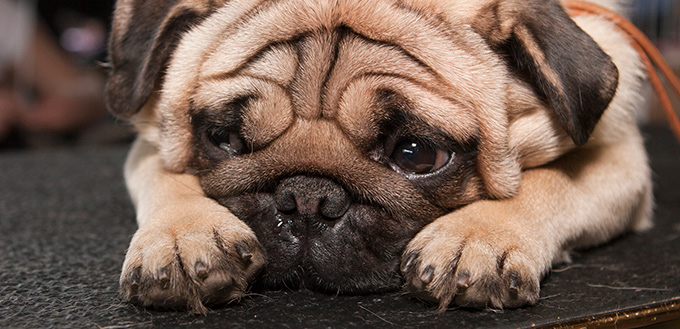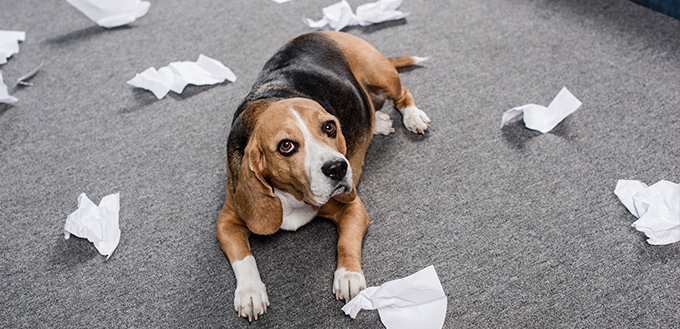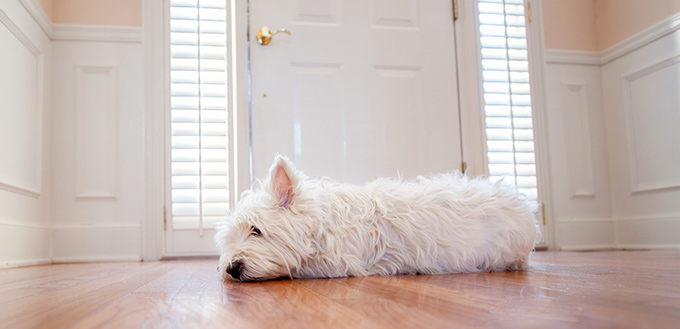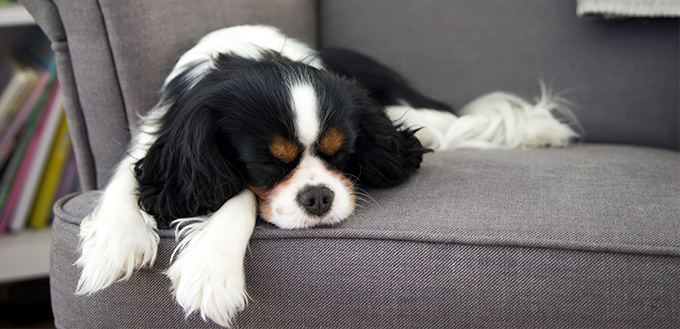Dogs are highly social creatures and they crave company. In the wild, dogs live in groups or ‘packs’ and do not like to be alone. Thanks to may years of careful breeding, domestic dogs are now perfect companion animals who like nothing better than to be with the human family that they adore. Given the choice, the majority of dogs would spend every hour of the day with their human pals but the problem here is that humans have got other things to do!
With the exception of guide dogs for blind people and some medical alert dogs, it is simply not possible to have our dog with us for 24 hours a day, even if we would like to. This presents our dog with a problem because they do not like to be alone. Many develop a canine condition that is termed ‘separation anxiety’ which can be very distressing for both the dog and owner.

How Separation Anxiety Affects Your Dog
As the name suggests, separation anxiety is a feeling of anxiousness, nervousness, and fear that a dog develops when they are not in contact with their human family. It can escalate into complete panic.
Dogs can’t tell you how they are feeling but, when it comes to separation anxiety, they are very good at showing it! A dog that has separation anxiety will often exhibit very inappropriate behavior when they are left at home and that behavior can be destructive. However, they can also show it in more subtle ways that you may not have picked up on.
Have you noticed that your dog is doing any of the following?
- Seeking you out in the day. Perhaps your neighbors have reported that they can hear your dog pawing at doors and windows and barking when you are not at home. This is a sign that your dog is unhappy and is trying to find you!
- Following you around. Has your dog started shadowing you when you are home and refusing to let you out of their sight? This is a sure sign that they are frightened that you are going to disappear again and leave them home alone.
- Seeking you out for reassurance. Dogs with separation anxiety lose confidence and tend to turn to their owners for comfort whenever anything unexpected occurs.
- Over-enthusiastic greeting. We all love to be greeted by our pooch at the end of a long day but if the greetings have become over-exuberant it should set alarm bells ringing.
These signs are often misinterpreted by owners as merely indicators that their dog loves them but they are also subtle signs that a pooch is suffering from separation anxiety. You need to do something about this quickly because it could get worse.
The signs of more serious separation anxiety are as follows:
- Vocalization. This is the scientific name for barking, whining, howling or any other noise that your dog can produce to make it quite clear that they are not happy about being left alone. Your neighbors will be able to tell you that this is happening and they may not be very pleased about it.
- Destructive behavior. Typically, dogs with separation anxiety will chew and claw/scratch at objects within your home. The areas around doors, windows, crates, and fences are particular targets as your dog tries to escape. However, they have also been known to rip sofas apart and chew up carpets.
- Defecating and urinating in the house. When a previously house-trained dog starts to pee and poop in your house, they are trying to tell you something. It can mean that they are suffering from separation anxiety and are not happy about being home alone.
Check out our guides on the Best Dog Proof Trash Cans and Best Indoor Dog Potty.

Diagnosing Separation Anxiety
It is important not to jump to conclusions about what is causing your dog’s behavior. There are several other potential causes (both physical and psychological) that need to be eliminated first.
The only way to be sure about how your dog is behaving when they are alone is to install a dog camera so that you can observe it for yourself. The best dog cameras will record sound and visual images but you may need to move them around the house to build up a complete picture of what is going on.
Separation anxiety is usually at its peak during the first hour after you have left the house. Your dog may hide, whine or pant and act in a depressed way. Then they may start to destroy things, pee, or poop in the house. They are unlikely to eat.
Related Post: Best Dog Pooper Scooper
You can show the video to your vet or to an animal behavior expert who will make a diagnosis and help to work out a plan of action. There is no single cure for this problem.
What Doesn’t Work
Before we go into detail about the tricks that can help separation anxiety it is important to be clear about what will not work.
Getting angry will not help. Obviously, you will feel disappointed and frustrated when you are met by a disgruntled neighbor who has been disturbed by continuous barking or by a wrecked house. Your dog will sense that you are annoyed and will adopt ‘appeasement behavior’ which they show by flattening their ears, lowering their body, and placing their tail between their legs. Some even look as if they are cringing and owners mistakenly think that the dog knows what they have done wrong. They don’t. They are just responding to you being upset.
Punishment of any kind is completely the wrong response and is very likely to be counter-productive. Dogs associate punishment with what they are doing right now and not what they have done in the past! Your poor dog is already terrified for long periods of time, perhaps five days a week. If you punish them, you will be making them even more terrified.
It also will not help if you get uptight and nervous yourself or if you adopt behavior that reinforce “neediness” in your dog. Inconsistency is also a problem. Once you have formulated a plan of action, it is important that you stick with it and that all of the other members of the family do the same.

Tips and Tricks to Help Separation Anxiety
There are plenty of things that you can do to make being home alone less stressful for your dog and therefore easier on you! Your vet or an animal behavior expert will be able to give you specific advice. Here are the main strategies that can be very useful. They can be divided into behavioral and environmental approaches.
Behavioral Modifications
- Identify anxiety triggers
Separation anxiety is all about fear and your aim is to make your dog feel safe when you are not there because they are confident that you will return. Gradually, you need to eliminate the fear but it will take time. The first step is to carefully analyze their current behavior. Ask yourself what you do as you get ready to leave and what your dog does at this time. By doing this, you can identify the sights and sounds that trigger anxiety in your dog. It could be the sight of you putting on your shoes or the sound of your house keys jangling. The triggers are different for every dog and for every household. This provides you with an intervention point.
- Work on the intervention points
Pretend to leave your home by going through your usual routine of putting on your coat etc. Walk to the door but then take your coat back off and sit back down. Keep doing this until your dog remains calm when you put on your coat.
The next stage is to actually go out of the door but come straight back in and then increase the amount of time you stay away but do it very gradually. Perhaps start to walk around the block or pop to the store. By building up the time, your dog will learn that you are coming back and will not feel so anxious. It can take a few days for this to work.
- Work on how you behave at home
You need to prevent your dog from being so needy and from relying so heavily on your company. Don’t make a huge fuss of them when you come home. Ignore them until they calm down and then stroke them and talk to them calmly.
Don’t allow them to sleep on your bed so they know that they cannot always be you. It can also help is someone else take your dog for a walk so they learn to enjoy being with other people.

Environmental Modifications
There are plenty of environmental changes that you can make but, again, you need to analyze the current situation first. Think about what your dog destroys and where they are when they do it. Also, think about what toys they have available to keep them amused.
- Home modifications
Sometimes dog doors can be helpful so that your dog can get out into a yard or garden to poop or pee or to run around.
Stair (dog) gates are highly effective tools for when you are getting your dog accustomed to being left home alone. They are less frightening than a normal closed door because your dog can see through them. When you are home, you can use them to get your dog used to there being some way away from you. They will be able to see, smell and hear you but can’t get to you. Some dog pens can be used to fence off certain areas of your house in the same way.
Related Post: Best Dog Gates
Always make sure that your dog has a comfortable bed and plenty of fresh water. It can help if you put some clothes of your own in your dog’s bed to make them feel secure and feel that you are near them. Don’t wash the clothes first, they need to smell like you!
Related Post: Best Dog Water Fountain
- Toys and treats
Rotating dog toys is a highly effective strategy. Boredom can play a big part in separation anxiety so do your best to keep your pooch amused when you are not there. Keep some highly interactive dog toys, and a snuffle mat, to one side and only give them to your dog when you are not there.
Related Post: Toys for Blind Dogs
Dog puzzle toys are a good option here. They have holes and cavities where you can hide tasty treats and it can take a dogs hours to remove them.
- Comforting noise
If your home is usually full of noise from radios and TVs, it is not surprising that your dog finds it strange when you have all gone out and the house is in silence. Many dogs find it comforting to have a TV playing on a low volume when you are out.
The sound can also help to muffle any startling sounds from outside in the street that may frighten your dog. Talking stations are more popular with dogs than loud music!
Other Options For Separation Anxiety
If all this fails, you may want to consider medication. You can buy some anxiety remedies for dogs but you should always consult your vet first to check that it is safe for your pooch to take them. Your vet may also be able to prescribe some medication that can help. Some medication is given in tablet form and others are sprays. Some are based on natural pheromones.
It is important that you treat this medication as a way of making the behavioral and environmental modifications more effective. They are not to be used in isolation. The plan is for you to gradually reduce the dose of the medication as the modifications start to work so that eventually it is not required.
The final option may be for you to use a ‘dog nursery’ or a pet sitter but these are obviously not financially viable for everyone.
Sources:
- Dealing with Separation Anxiety in Dogs, The MSPCA–Angell
- Separation Anxiety, The ASPCA
- Sherry Woodard, Separation Anxiety in Dogs, Best Friends Animal Society






